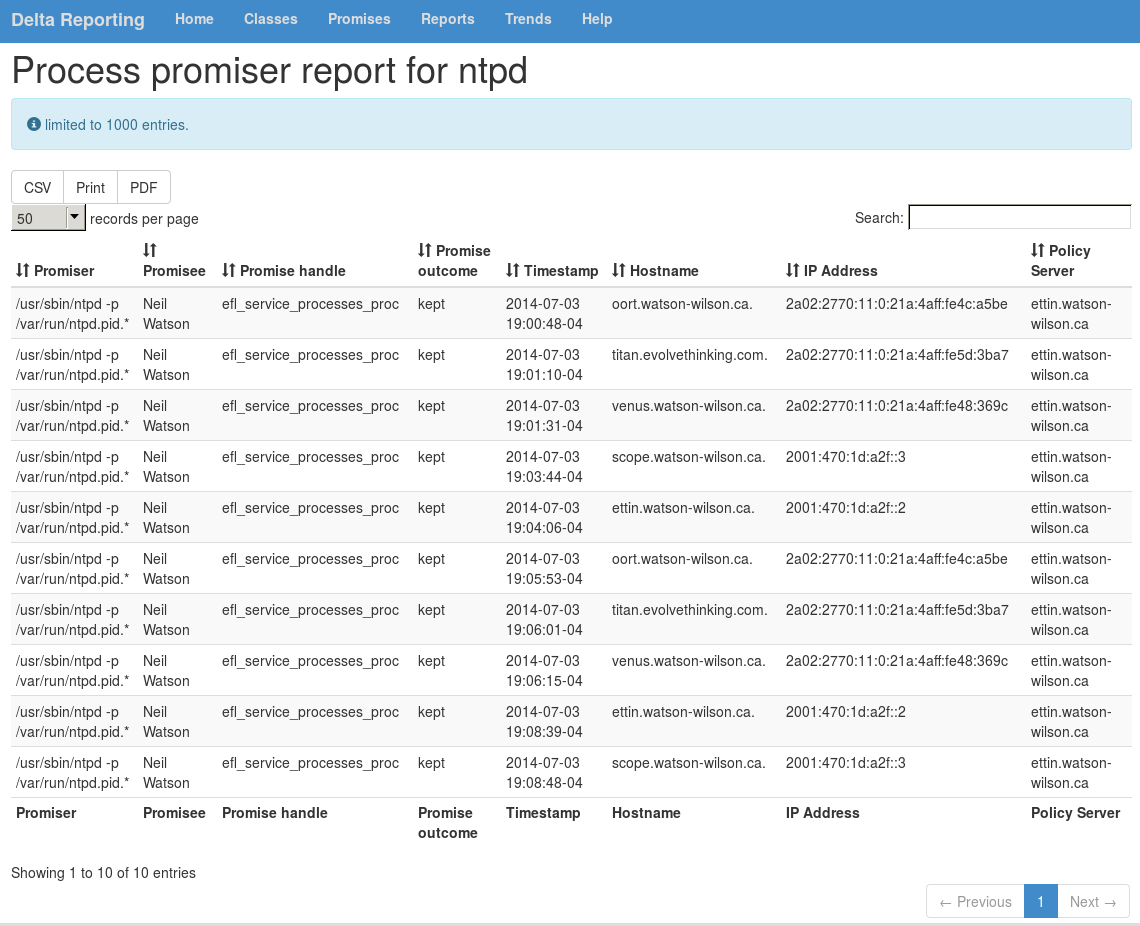CFEngine best practices: testing

CFEngine's autonomous automation means that your policy, mistakes and all, will be duplicated quickly to all of your hosts. --- Potentially tens of thousands of them. When I taught martial arts it was humbling to watch a class of thirty duplicate my incorrect movement. I didn't know, because I didn't test myself. In martial arts I was simply embarrassed, but in configuration management, mistakes could cost me a raise or even my job. Testing is the paramount best practice for CFEngine. Let me tell you what I have learned.
Prototyping
Your first kernel of a policy idea should be demonstrated with a small, self contained, prototype. Try to keep your prototype to a single file. If you need bundles or bodies from policy libraries, copy just what you need from them into your prototype file. There are good examples on the Internet get you started.
The Vim CFEngine plugin has a built in skeleton policy file. In command mode ,k will insert the skeleton into the current buffer. This plugin's syntax highlighting will alert you about missing quotations and other syntax issues. If you are in the church of Emacs, there is an Emacs CFEngine plugin elsewhere on the web (its home is nebulous so I provide no link).
CFEngine ships with many self contained examples that you can study. They are located in share/doc/examples in CFEngine's work directory (typically /var/cfengine).
Figure 1: Standalone unit test that ships with CFEngine.
ettin:/var/cfengine/share/doc/examples# cat unit_depends_on.cf
body common control
{
bundlesequence => { "one" };
}
bundle agent one
{
reports:
cfengine_3::
"two"
depends_on => { "handle_one" };
"one"
handle => "handle_one";
}
- Many CFEngine bug reports (especially mine) contain good self contained examples. Indeed, if you report CFEngine bugs, be sure to include a small prototype to demonstrate the undesired behaviour.
Formal testing
Use real test plans. Don't just test that your policy works, prove it. You can even use CFEngine for unit testing. Let's look at an example. In practice I recommend you use the Free Promise Library(EFL), or some other policy framework, because they have ready to use policies that will save you a lot of time, but for this example we'll keep it small and hand made. I want you to see the concept rather than the actual implementation.
We want a policy that will start a service if it is not running. Start by breaking this down into basic components that translate into CFEngine promises. Another best practice with CFEngine is to think in terms of processes, commands, and files. Virtually everything in UNIX is one of those three things. We can restate out example as promising to run a command if a process is not found. In this example our process is sleep 99 and the command is /tmp/proto.sh.
Here's my prototype. Note the init bundle, I use that to promise our service start script. By including it here my prototype is self contained. The bundle proto promises to define the class start_service_proto_sh if the process sleep 99 is not found. The commands process runs our init script from the init bundle if the class start_service_proto_sh is true. Also, note that the body parts at the bottom are copies of bodies from the standard CFEngine library, except the by_command body which is from EFL.
Figure 2: My first prototype.
body common control
{
bundlesequence => { "main", };
}
bundle agent main
{
methods:
"Initialize prototype" usebundle => init;
"My prototype" usebundle => proto;
}
bundle agent init
{
meta:
'Purpose' string => 'Initialize prototype service script';
vars:
'service_script[location]' string => "/tmp/proto.sh";
'service_script[contents]' string =>
"#!/bin/sh
exec 1>&- # close stdout
exec 2>&- # close stderr
sleep 99 > /dev/null &
exit 0
";
files:
"${service_script[location]}"
comment => "Promise working script for testing",
create => 'true',
perms => m('755'),
edit_defaults => empty,
edit_line => insert_lines( ${service_script[contents]} );
}
bundle agent proto
{
meta:
'Purpose' string => "Promise to start service if not running.";
processes:
"sleep 99"
comment => "Test for desired process",
process_select => by_command( "\Asleep 99\Z" ),
restart_class => "start_service_proto_sh";
commands:
start_service_proto_sh::
"${init.service_script[location]}"
contain => in_shell;
}
body contain in_shell
{
useshell => "true";
}
body edit_defaults empty
{
empty_file_before_editing => "true";
edit_backup => "false";
}
bundle edit_line insert_lines(lines)
{
insert_lines:
"$(lines)"
comment => "Append lines if they don't exist";
}
body perms m(mode)
{
mode => "$(mode)";
}
body process_select by_command( command )
{
command => "${command}";
process_result => "command";
}
Note that in the processes promise I use the process_select attribute. This may seem a duplicate of the promiser itself, but the difference is subtle. The promiser is matched against the entire line from a ps command. The process_select body uses the command attribute to match against the ps command's command column only. I also anchor the regular expression with \A and \Z. These extra details reduce the chances of false positive matching.
During the process of writing this policy I frequently used the CFEngine program cf-promises to test my syntax.
Figure 3: Testing syntax
neil@ettin ~/.cfagent/inputs $ cf-promises -cf ./service.cf neil@ettin ~/.cfagent/inputs $ echo $? 0
If there was an error cf-promises would have shown it to me, and it would have returned a none zero status.
Cf-promises will give line numbers to indicate the location of your error, but the error is often located at the line before the given line. Also, one error can result in a cascade of errors, so start with the first error listed.
Let's run our test. It's important to know our expected results. If sleep 99 is not running I expect proto.sh to be run. If sleep 99 is running I expect nothing to happen. Let's try it.
Figure 4: Our first prototype run
neil@ettin ~/.cfagent/inputs $ cf-agent -KIf ./service.cf ; ps -ef |grep sleep ;cf-agent -KIf ./service.cf
2014-07-03T19:48:21-0400 info: /default/main/methods/'My prototype'/default/proto/processes/'sleep 99'[0]: Making a one-time restart promise for 'sleep 99'
2014-07-03T19:48:21-0400 info: /default/main/methods/'My prototype'/default/proto/commands/'/tmp/proto.sh'[0]: Executing 'no timeout' ... '/tmp/proto.sh'
2014-07-03T19:48:21-0400 info: /default/main/methods/'My prototype'/default/proto/commands/'/tmp/proto.sh'[0]: Completed execution of '/tmp/proto.sh'
neil 102836 1 0 19:48 pts/6 00:00:00 sleep 99
neil 102838 35478 0 19:48 pts/6 00:00:00 grep --color=auto sleep
Success! This is a good first prototype, but I want more and continuous testing. Now, I'll add a unit test that makes the agent break its own configuration. I add this bundle to our prototype file and change the methods in the main bundle.
Figure 5: Adding a unit test
## Change main bundle:
bundle agent main
{
methods:
"Initialize prototype" usebundle => init;
unit_01::
"unit_01" usebundle => unit_01;
any::
"My prototype" usebundle => proto;
}
# Added unit test bundle
bundle agent unit_01
{
meta:
'Purpose' string => "Kill process unit test";
processes:
"sleep 99"
comment => "Test for desired process",
process_select => by_command( "\Asleep 99\Z" ),
signals => { "term", "kill" };
}
Now we have a bundle unit_01 that is called when the same named class is true. This will kill the sleep 99 process forcing the proto bundle to restart it.
Figure 6: Unit test in action.
neil@ettin ~/.cfagent/inputs $ cf-agent -KIf ./service.cf -D unit_01 ; ps -ef|grep sleep
2014-07-03T19:15:06-0400 info: /default/main/methods/'unit_01'/default/unit_01/processes/'sleep 99'[0]: Signalled 'term' (15) to process 107369 (neil 107369 1 107360 0.0 0.0 4216 0 356 1 19:14 00:00:00 sleep 99)
2014-07-03T19:15:06-0400 info: /default/main/methods/'unit_01'/default/unit_01/processes/'sleep 99'[0]: Signalled 'kill' (9) to process 107369 (neil 107369 1 107360 0.0 0.0 4216 0 356 1 19:14 00:00:00 sleep 99)
2014-07-03T19:15:06-0400 info: /default/main/methods/'My prototype'/default/proto/processes/'sleep 99'[0]: Making a one-time restart promise for 'sleep 99'
2014-07-03T19:15:06-0400 info: /default/main/methods/'My prototype'/default/proto/commands/'/tmp/proto.sh'[0]: Executing 'no timeout' ... '/tmp/proto.sh'
2014-07-03T19:15:06-0400 info: /default/main/methods/'My prototype'/default/proto/commands/'/tmp/proto.sh'[0]: Completed execution of '/tmp/proto.sh'
neil 107437 1 0 19:15 pts/6 00:00:00 sleep 99
neil 107439 35478 0 19:15 pts/6 00:00:00 grep --color=auto sleep
For a more complex policy you can have multiple scenarios that must be repaired, each one being a separate unit test.
Large scale testing
In a prefect world we are all running a single flavour of UNIX. When you find this utopia tweet me!. Until then we must test our policy on all our different host types. In a really small shop you may manually copy your prototype, conveniently a single file, to your different hosts types and run it on each.
The rest of us are not so fortunate and will have to test our policy on more than a few hosts. A less manual approach is to integrate this prototype into your main policy, but only run it on select hosts. Then you can check each host to see if it is working. If you are using central reporting tools like Rudder, CFEngine Enterprise or Evolve's own Delta Reporting you'll be able to get reports showing your prototype in action on all of your test hosts.
Figure 7: Delta Reporting showing an ntp process promise on multiple
hosts 
Summary
This ends my entry on testing best practices. Let's review.
Start with simple prototypes.
Use editor plugins.
Check syntax with cf-promises.
Test formally, including unit tests.
Test on multiple architectures. Use reporting for scale.
